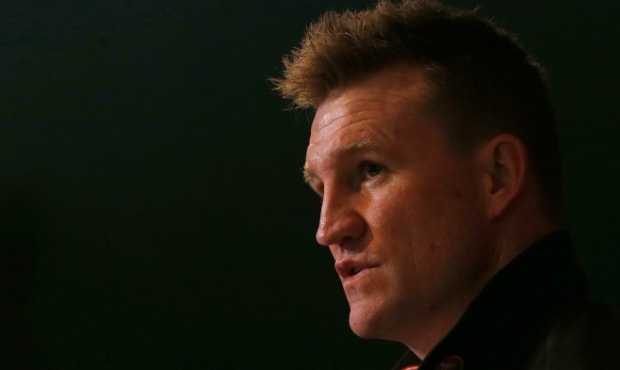"It's simply a plan. What it has done for us is give young players a roadmap of how they're going to get the best out of themselves at this footy club," Buckley said.
From the outside, Leading Teams appears just another example of a club unwilling to stand still, regardless of the adjustment it requires.
Collingwood has been courageous enough to change throughout the past four years. And it shows no signs of stopping.
What is Leading Teams?
In 2013, the club has used 38 players – the same number as Gold Coast, the Western Bulldogs and Melbourne, and five fewer than the statistical outlier, Greater Western Sydney.
Seven players have made their debuts so far.
Fifteen players from Collingwood's 2010 premiership team were in the side in round two. That figure has not been topped.
Last week against Adelaide, that number was 12.
Ben Johnson has retired. Alan Didak has played just two games. Dayne Beams, Dale Thomas and Tyson Goldsack have missed most of the season through injury. Alan Toovey is gone for the year but has just re-signed. Beams played last Friday night. Goldsack returns this week.
In the blink of an eye, Collingwood will depend on a new generation as it has depended on Dane Swan, Heath Shaw, Nick Maxwell, Harry O'Brien, Travis Cloke and co. in years gone by.
Since round nine, 2009, when the last rebuild got going under Mick Malthouse, Collingwood's winning record has been 76 percent, with two ties.
This year, it has done well to win 10 from 15 (66 percent) as well as manage a momentum shift in personnel.
Although form may have been patchy at times (the Pies have won just 29 of 60 quarters), the foundation of the next era is being built.
Collingwood's free agency recruits – Clinton Young, Jordan Russell and Quinten Lynch – have not achieved much, on-field at least, but the decision to take them allowed the Magpies to both build and hope to stay in contention.
It would have been much easier to stick with Chris Dawes and Sharrod Wellingham but if they had there is little chance the talented trio of Brodie Grundy, Tim Broomhead and Ben Kennedy would be on the list.
Those three – who look good at VFL level – sit under nine players who played last week that are younger than last year's best and fairest winner Dayne Beams.
Aged 23 and 151 days last Friday, Beams joined 100-gamer Steele Sidebottom, Jarryd Blair, Jamie Elliott, Marley Williams, Paul Seedsman Ben Sinclair, Josh Thomas and Jarrod Witts in the team that defeated Adelaide.
This week it added another youngster, Irishman Caolan Mooney, to the team.
This push towards youth is seen a major driver in the decision to implement Leading Teams.
When Scott Pendlebury spoke about the program last week he emphasised its role in allowing more players to contribute in meetings and lift standards on field, necessary for any club initiating a new batch of players.
"We've had great buy-in in meetings we've had and players are talking up in meetings so it's been great to not just have three or four boys speaking up in meetings, we've had 15 or 20 voices talking," Pendlebury said.
In round 16, 167 of the 396 AFL players were Beams' age or younger, an average of nine per team.
Hawthorn, the Sydney Swans and Carlton were below the average with five each who were younger than Beams while Port Adelaide, the Suns and the Giants were above the average.
The shift towards youth surely makes Collingwood's battle to be a genuine premiership threat tougher this season.
Below: The architect of Collingwood's regeneration. Can Nathan Buckley build a list to claim the flag?

After Gold Coast and the Giants, the Pies play Essendon, Hawthorn and the Sydney Swans.
The latter three beat Collingwood by an average of 49.3 points earlier in the season.
That's a big gap to make up. Buckley and the players remain upbeat that the trend is positive. Players are returning from injury and the coach can point to improved defensive numbers.
In the first five games, Collingwood conceded on average 106 points. In the next five rounds that average decreased to 85. In the past five rounds it's fallen further still to 70 points a game.
The trend might be misleading however. Between rounds one and five Collingwood played three of this year's top five scoring teams. All five have kicked more than 1400 points this season.
In the past five games the Magpies have met four teams that have scored less than 1400 points for the season, including the Western Bulldogs and Melbourne, teams whose scorecard each game looks more like someone who has just played a round of golf.
As Buckley knows, time will tell.
"We're continually trying to hone our strategies to contend against the best teams," Buckley said.
"We'll find out about that soon enough but we've just got to keep on this trend of improving defensively and we think that will give us the best chance to compete."
He might find out where Collingwood sits for 2013, but even if it has not made significant ground on Hawthorn and others a realistic assessment would suggest the club is on track to pass the current contenders at some stage in the next 18 months.
Patience may not be a virtue with Collingwood supporters but anyone worried about the direction – and the influence of Leading Teams – needs to take a long look at the reasons behind any shift that might be necessary.


